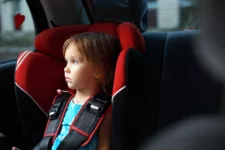In 2015, 663 children aged 12 and under died in car accidents. Among those children, 35% were not buckled up.
Even if you’re only going on a short trip to the store down the street, it’s imperative to use a car seat.
Using a car seat is important, but it’s equally important to make sure that you’re using the seat properly. Here are five car seat safety tips that every parent should know.
1. Make Sure the Straps are Tight Enough
One of the most common issues with car seats is that parents do not strap their children in properly. Loose straps won’t provide your child with the same level of protection that snug straps will provide.
After you’ve buckled your child in, pinch the car seat strap up near the shoulders. Can you pinch a wrinkle? If so, the strap is too loose. Tighten the belt until it’s snug.
Once the straps are tight enough, check to make sure the seat itself is strapped in tightly. While holding onto the bottom of the seat, tug from side to side. If the seat moves more than an inch in any direction, tighten the belt.
The goal is to keep the seat and your child in place in case of an accident. Loose straps can cause the seat to topple over or send your child forward to cause potential injury.
2. Remove Winter Jackets Before Buckling Up
When the weather gets cold and you’re running late for work, it’s easy to forget this one crucial safety tip: always remove winter jackets before buckling up.
While inconvenient, a coat can actually prevent the harness from doing its job. Coats add extra bulk, which means the straps won’t fit properly.
If you do get into an accident, the coat may compress, which means the straps will be too loose to provide the appropriate amount of protection.
To ensure that the seat fits properly every time, remove all coats – even light ones – before buckling up.
3. Children Should Ride in Rear-Facing Seats Until Age 2
All children under the age of 2 should ride in a rear-facing seat. The only exception is if the child outgrows the weight and height limits for these seats (45 pounds).
Previous guidelines recommended that children start riding in forward-facing seats once they reach 20 pounds, but this guideline is now outdated.
Children who ride in rear-facing seats until at least age 2 are 75% less likely to die or become seriously injured in a car accident.
Contrary to popular belief, children are actually at less of a risk of leg injury if they’re in a rear-facing car seat. Forward-facing seats increase the risk of this type of injury because the child’s legs come in contact with the seat in front of them, which is moving backward.
4. Kindergarteners Should Ride in Safety Seats, Too
The American Academy of Pediatrics (AAP) recommends that children remain in a four-point harness until at least age 4.
Harnessed car seats can safely secure children up to 65 pounds, which means most kindergarteners can safely ride in them.
For older children, experts recommend choosing a seat with tethers that extend from the top back of the seat to the rear, where they are anchored down. These types of seats can help prevent a child’s head from being flung forward in an accident.
5. Know Which Type of Front-Facing Seat You Need
When your child is ready to graduate to a forward-facing seat, it’s important to make sure that you choose the appropriate type of seat. There are four main types, which include:
Forward-Facing-Only Seats
A forward-facing only seat is best suited for children who are 40-80 pounds. These types of seats are no longer made by manufacturers, but you may still come across old models from previous years.
Convertible Seats
Convertible seats can be used either rear-facing or forward-facing. This category also includes 3-in-1 seats.
Travel Vests
A travel vest can be worn by a child who is 20-168 pounds, and is an alternative to conventional forward-facing seats.
Vests are ideal for vehicles with lap-only belts in the rear, for children who exceed the weight limit of traditional car seats, and kids with special needs.
Combination Seats w/Harness
Seats that can be placed forward-facing. These include a harness, and are ideal for children weighing 40-90 pounds. These seats can be used without the harness for children 80-120 pounds.
Choosing the right seat for your child and vehicle will play an integral role in ensuring that your little one is protected in case of an accident.








